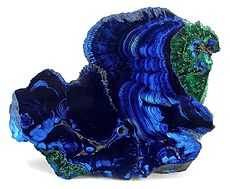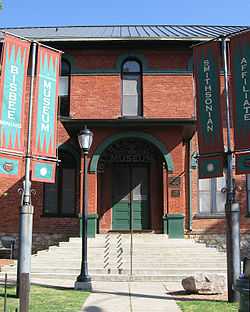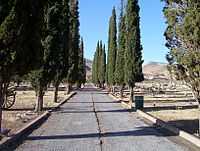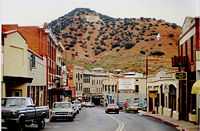Bisbee, Arizona
| Bisbee, Arizona | |
|---|---|
| City | |
 | |
 | |
| Coordinates: 31°25′6″N 109°53′52″W / 31.41833°N 109.89778°WCoordinates: 31°25′6″N 109°53′52″W / 31.41833°N 109.89778°W | |
| Country | United States |
| State | Arizona |
| County | Cochise |
| Incorporated | January 9, 1902 |
| Government | |
| • Mayor | Adriana Zavala Badal |
| Area | |
| • Total | 4.8 sq mi (12.5 km2) |
| • Land | 4.8 sq mi (12.5 km2) |
| • Water | 0.0 sq mi (0.0 km2) |
| Elevation | 5,538 ft (1,688 m) |
| Population (2007)[1][2] | |
| • Total | 5,996 |
| • Density | 1,286.9/sq mi (494.2/km2) |
| Time zone | MST (no daylight saving time) (UTC-7) |
| ZIP code | 85603 |
| Area code | 520 |
| FIPS code | 04-06260 |
| Website | www.cityofbisbee.com |
Bisbee is a city in Cochise County, Arizona, United States, 82 mi (132 km) southeast of Tucson. According to 2005 Census Bureau estimates, the population of the city was 6,177.[1] The city is the county seat of Cochise County.[3]
History
Bisbee was founded as a copper, gold, and silver mining town in 1880, and named in honor of Judge DeWitt Bisbee, one of the financial backers of the adjacent Copper Queen Mine.
In 1929, the county seat was moved from Tombstone, Arizona, to Bisbee, where it remains.
Mining industry

Mining in the Mule Mountains proved quite successful: in the early 20th century the population of Bisbee soared. Incorporated in 1902, by 1910 its population swelled to 9,019 and it sported a constellation of suburbs, including Warren, Lowell, and San Jose, some of which had been founded on their own (ultimately less successful) mines. In 1917, open pit mining was successfully introduced to meet the heavy copper demand due to World War I.
High quality turquoise was a by-product of the copper mining and has been promoted as Bisbee Blue. Bisbee is noted for the variety of copper minerals and the high-quality specimens that have been taken from its mines. Bisbee specimens can be found in museums worldwide. Cuprite, aragonite, wulfenite, malachite, azurite, and galena are just a few of the minerals that have been found underneath the town.
Bisbee deportation
- For full article see: Bisbee Deportation
In 1917, the Phelps Dodge Corporation shipped more than 1,000 striking miners out of the town at gunpoint, because they were believed to be members of the Industrial Workers of the World and the company was trying to prevent unionization.[4] They were transported to Hermanas, New Mexico. Earlier in that year of national labor unrest, in central Arizona, the Jerome Deportation took place.
Mining decline and closure
By 1950, boom times were over and the population of the City of Bisbee had dropped to less than 6,000, but the introduction of open-pit mining and continued underground work would see the town escape the fate of many of its early contemporaries. However, in 1975 the Phelps Dodge Corporation finally halted its Bisbee copper-mining operations. The resulting exodus of mine employees might have been the end of the town. Phelps Dodge Corporation closed the Bisbee underground mines in the summer of 1975. Bisbee Mayor Chuck Eads, with the generous cooperation of Phelps Dodge, brought to reality the idea of opening a mine tour through a portion of the world-famous Copper Queen Mine. Mayor Eads felt that history of mining should be kept alive in Bisbee and in a manner that would attract tourists to the community. Many faithful volunteers cleared thousands of tons of fallen rock and re-timbered the old workings. They were assisted by local individuals and groups who furnished support and food for the workers. The local effort came to the attention of a federal agency, the Economic Development Administration, which approved a large grant to the City of Bisbee to help the mine tour project and other improvements in downtown Bisbee designed to aid the tourist business. The Queen Mine Tour was officially opened to visitors on February 1, 1976. Since then, more than a million visitors, from all 50 states and more than 30 foreign countries, have enjoyed the ride into the mountain on the underground mine tour train. Bisbee survived and remains as the county seat.

Modern Bisbee
The sudden flood of real estate onto the market and crash in housing prices, coupled with an attractive climate and picturesque scenery, led to Bisbee's subsequent rebirth as an artists' colony in the early 1970s. Artist Stephen Hutchison and his wife, Marcia, purchased the town's anchor business and architectural gem, The Copper Queen Hotel, from the Phelps-Dodge mining company in 1970 after the company had failed to find a local buyer. The deed to the hotel had been offered to any local resident for the sum of $1.00, with no success.

Hutchison purchased and renovated the hotel, as well as other buildings in the downtown, which included a start of the 20th century Brewery and Stock Exchange. Hutchison began to actively market Bisbee as a destination where travelers could find the authentic, old southwest. Hutchison's endeavors attracted developer Ed Smart. Among the many guests at the hotel were celebrities from nearby California. John Wayne was a frequent visitor to Bisbee and The Copper Queen. He befriended Hutchison and eventually partnered with Smart in his real estate ventures. This period of Bisbee's history is well documented in contemporary articles in The New Yorker and in an article by Cynthia Buchanan in The Cornell Review. It was at this time that Bisbee became a haven for artists and hippies fleeing the larger cities of Arizona and California and, later, the increasing gentrification of places like Aspen, Colorado.
The rediscovery of Bisbee by baby boomers in the 1990s saw it develop a more polished look, complete with coffee shops and live theater. Many of the old houses have been renovated, and property values in Bisbee now greatly exceed those of other Southeastern Arizona cities.
Today, the original city of Bisbee is known as "Old Bisbee", and is home to a thriving downtown cultural scene. Old Bisbee is also noted for its architecture, including its Victorian style houses and elegant Art Deco courthouse. Because its plan was laid out before the automobile, Old Bisbee has an almost European feel. The town's hilly terrain is exemplified by the old four-story high school: each floor has a ground-level entrance.

Quirky
In the May–June 2000 issue of Modern Maturity, the AARP highlighted what they called the most 'alive' places to retire in the U.S. Bisbee was a runner-up as one of the "quirkiest" towns in America.[5]
Suburbs

The city of Bisbee now includes the historic downtown Bisbee, as well as the geographically spaced but administratively combined satellite communities of Warren, Lowell, and San Jose. The Lowell and Warren townsites were founded around their own mining subdivisions before being purchased in large part by Phelps Dodge and then consolidated into Bisbee-proper during the early part of the twentieth century. There are also smaller neighborhoods interspersed between these larger boroughs including Galena, Bakerville, Tintown, South Bisbee, Briggs and Saginaw.
Warren has the distinction of being Arizona's first planned community. Although there were mines operating in the vicinity, it was primarily designed as a bedroom community for the more affluent citizens of the mining district. The centrally located Vista Park and its adjacent downtown area at one time comprised a thriving center of commerce. Warren boasts a fine collection of Arts and Crafts style bungalow houses, many of which are historically registered and can be visited by the public during the city's annual home tour. Since the exit of mining in the 1970s, Warren has seen a steady decline in its standard of living, but its residential district still houses a significant portion of the population and it boasts ownership of many public services including City Hall, Greenway Elementary School, Bisbee High School, and the historic Warren Ballpark.
Lowell was at one time a sizable mining town located just to the southeast of Old Bisbee. The majority of the original townsite was consumed by the excavation of the Lavender Pit mine during the 1950s. All that is left today is a small portion of Erie Street, along with Evergreen Cemetery, Saginaw subdivision and Lowell Middle School. These days Lowell is considered by most of the local residents to be more of a place name than an actual community.
San Jose, on the southern side of the Mule Mountains, is the most modern of the city's subdivisions, and has seen the most new growth in the last two decades as it is not restricted by mountains. Named after a nearby Mexican mountain peak, it hosts many newer county government buildings, Huachuca Terrace Elementary School, and a large shopping center.
Resurgence of mining industry
In 2007, in what has been noted as the world's biggest-ever mining takeover, Freeport-McMoRan Copper & Gold bought Phelps Dodge Mining[6] and has begun some preliminary work in the area.
Special events
The Bisbee 1000 Stair Climb is a five kilometer run through Bisbee that goes up and down 1,034 stairs. Because much of Old Bisbee is built in the hills of the Mule Mountains, many of the houses can’t be reached by car. Billed as "The most unique physical fitness challenge in the USA!" by the organizers,[7] it includes being serenaded by musicians at various locations among the stairs. The event has grown to include the Ice Man Competition, designed to honor the history of men delivering blocks of ice by hand before the advent of refrigeration. In the Ice Man Competition, entrants race up 155 steps carrying a ten-pound block of ice with antique ice tongs.
Gallery of mineral specimens from the Bisbee mining district
-

Spectacular example of layered azurite with malachite. Polished surface, overall size 8.6 x 7.5 x 3.1 cm.
-

Green clusters of malachite crystals fill the vugs in a matrix of solid, hackly native copper. Size: 7.4 x 6.2 x 4.3 cm.
-

Native copper, size 3.5 x 2.2 x 1.3 cm.
-

Botryoidal malachite, a classic old Bisbee specimen. Size 10.5 x 6.3 x 5.6 cm.
-

Dendritic native copper, 7.4 x 5.2 x 2.6 cm
-

Azurite on malachite, another classic old piece. 8.2 x 5.4 x 3.9 cm.
Naco and Bisbee Junction
Naco, Arizona is a small unincorporated border community some three miles south of the San Jose district of Bisbee. It straddles the Mexico – United States border and is home to an official port of entry. Naco features a U.S. Post Office, an elementary school, and several businesses, including a small store, garage, and saloon.
Bisbee Junction (formerly Osborn or Osborn Junction) is located four miles south of Warren. It was originally a railroad siding where ore trains from the Bisbee mines joined with the main Southern Pacific rail line. A Southern Pacific depot and U.S. Post Office building in the style of the first half of the 20th century originally stood at the railroad junction, but it was closed in the late 1950s and razed soon afterward. A dance hall, an Elks club and small dry goods store were once located near the depot, and the settlement was once home to several cattle ranches and dairies. The Arizona Cactus Botanical Garden was located in Bisbee Junction.
Geography
Bisbee is located at 31°25′6″N 109°53′52″W / 31.41833°N 109.89778°W (31.418390, -109.897772).[8]
According to the United States Census Bureau, the city has a total area of 4.8 square miles (12 km2), all of it land.
Climate
Bisbee has the typical semi-arid climate (Köppen BSk) of the upland Mountain West. Summer days are warm to hot and dry before the monsoon brings the wettest season from July to September with 10.65 inches (270.5 mm) of Bisbee’s total annual rainfall of 18.63 inches (473.2 mm). During the winter, frontal cloudbands may bring occasional rainfall or even snowfall, though average maxima in the winter are typically very mild and sometimes even warm.
| Climate data for Bisbee, Arizona | |||||||||||||
|---|---|---|---|---|---|---|---|---|---|---|---|---|---|
| Month | Jan | Feb | Mar | Apr | May | Jun | Jul | Aug | Sep | Oct | Nov | Dec | Year |
| Record high °F (°C) | 85 (29) |
85 (29) |
88 (31) |
95 (35) |
101 (38) |
106 (41) |
104 (40) |
101 (38) |
100 (38) |
98 (37) |
90 (32) |
78 (26) |
106 (41) |
| Average high °F (°C) | 57.3 (14.1) |
60.4 (15.8) |
65.7 (18.7) |
73.6 (23.1) |
81.2 (27.3) |
89.9 (32.2) |
88.8 (31.6) |
86.0 (30) |
84.2 (29) |
76.1 (24.5) |
65.8 (18.8) |
58.1 (14.5) |
73.93 (23.3) |
| Average low °F (°C) | 34.3 (1.3) |
36.1 (2.3) |
40.3 (4.6) |
46.2 (7.9) |
53.3 (11.8) |
62.2 (16.8) |
64.3 (17.9) |
62.5 (16.9) |
59.1 (15.1) |
50.2 (10.1) |
40.8 (4.9) |
35.5 (1.9) |
48.73 (9.29) |
| Record low °F (°C) | 6 (−14) |
11 (−12) |
21 (−6) |
27 (−3) |
32 (0) |
38 (3) |
53 (12) |
47 (8) |
41 (5) |
28 (−2) |
16 (−9) |
13 (−11) |
6 (−14) |
| Rainfall inches (mm) | 1.18 (30) |
1.20 (30.5) |
1.01 (25.7) |
0.46 (11.7) |
0.22 (5.6) |
0.70 (17.8) |
4.03 (102.4) |
4.64 (117.9) |
1.98 (50.3) |
1.05 (26.7) |
0.82 (20.8) |
1.34 (34) |
18.63 (473.4) |
| Snowfall inches (cm) | 3.4 (8.6) |
2.2 (5.6) |
1.4 (3.6) |
0.3 (0.8) |
0.0 (0) |
0.0 (0) |
0.0 (0) |
0.0 (0) |
0.0 (0) |
0.0 (0) |
0.5 (1.3) |
2.1 (5.3) |
9.9 (25.2) |
| Avg. rainy days (≥ 0.01 inch) | 4 | 4 | 4 | 2 | 1 | 3 | 13 | 13 | 6 | 4 | 3 | 4 | 61 |
| Source: Western Regional Climate Center[9] | |||||||||||||
Demographics
| Historical population | |||
|---|---|---|---|
| Census | Pop. | %± | |
| 1910 | 9,019 | ||
| 1920 | 9,205 | 2.1% | |
| 1930 | 9,023 | −2.0% | |
| 1940 | 5,853 | −35.1% | |
| 1950 | 3,801 | −35.1% | |
| 1960 | 9,914 | 160.8% | |
| 1970 | 8,328 | −16.0% | |
| 1980 | 7,154 | −14.1% | |
| 1990 | 6,288 | −12.1% | |
| 2000 | 6,090 | −3.1% | |
| Est. 2009 | 5,962 | ||
As of the census[10] of 2000, there were 6,090 people, 2,810 households, and 1,503 families residing in the city. The population density was 1,266.3 people per square mile (488.8/km²). There were 3,316 housing units at an average density of 689.5 per square mile (266.2/km²). The racial makeup of the city was 84.12% White, 0.46% Black or African American, 1.22% Native American, 0.49% Asian, 0.07% Pacific Islander, 11.07% from other races, and 2.58% from two or more races. 34.38% of the population were Hispanic or Latino of any race.
There were 2,810 households out of which 21.7% had children under the age of 18 living with them, 36.8% were married couples living together, 12.8% had a female householder with no husband present, and 46.5% were non-families. 39.1% of all households were made up of individuals and 14.6% had someone living alone who was 65 years of age or older. The average household size was 2.15 and the average family size was 2.90.
In the city the age distribution of the population shows 21.6% under the age of 18, 6.8% from 18 to 24, 24.1% from 25 to 44, 27.8% from 45 to 64, and 19.6% who were 65 years of age or older. The median age was 43 years. For every 100 females there were 90.6 males. For every 100 females age 18 and over, there were 85.1 males.
The median income for a household in the city was $27,942, and the median income for a family was $36,685. Males had a median income of $29,573 versus $23,269 for females. The per capita income for the city was $17,129. About 12.9% of families and 17.5% of the population were below the poverty line, including 23.2% of those under age 18 and 9.0% of those age 65 or over.
Government
Bisbee is governed via the mayor-council system. The city council consists of six members who are elected from wards. Each ward elects two members, The mayor is elected in a citywide vote.[citation needed]
Sites of interest
(excluding those mentioned under History)
- Bisbee Municipal Airport
- Cochise County Courthouse is built in the art deco style.
- Copper Queen Mine was once a major copper producer and can be toured daily.
- Phelps Dodge General Office Building, a National Historic Landmark, now the Bisbee Mining & Historical Museum.
- The Lavender Pit is an inactive open pit mine site in the center of the city.
- The Warren Ballpark, a baseball stadium built in 1909, has housed a number of professional teams and may be baseball's oldest park still in use.
- The Thomas Ranch, a family-owned and operated beef cattle ranch since 1902, the year Bisbee was incorporated.
- The Central School, built in 1905, was once an elementary school and now functions as an art center.
-

Cochise County Courthouse -

Copper Queen Mine Tour -

Bisbee Mining & Historical Museum -

The Lavender Pit -

Evergreen Cemetery -

Downtown Bisbee, 1990
Sports teams
Bisbee joined with Clifton in forming a cricket team that travelled to Santa Monica, California in 1908 to play the Santa Monica Cricket Club in two games overlooking the Pacific Ocean on the grounds of the Polo Field. The miners lost both cricket games. Ref: David Sentence, Cricket in America 1710-2000 (McFarland:N.Carolina, 2006) 192 The Copper Echo reported that Bennie, the general manager of the Shannon Company Copper Mine was the miner's best cricketer.
- Professional: Bisbee/Douglas Copper Kings (1928–1955) (2003) Baseball
- Semi-Professional: Bisbee Kings (2006-) Baseball
Popular culture
.jpg)
Literature
- Joanna Brady is the protagonist of a series of mystery novels by author J. A. Jance, centered on Bisbee and surrounding desert-mountain-border areas.
- It is one of the towns robbed by the "Butcher Bandit" in Clive Cussler's 2007 novel, The Chase.
Film
- In 2000, the low-budget William Shatner film Groom Lake was filmed in and around Bisbee, using many local residents as extras.
- In the 1990 film Young Guns II, the New York City classroom from which Pinkerton agents drag reformed outlaw Doc Scurlock (Kiefer Sutherland) is actually in Bisbee's historic district.
- Stephen King's "Desperation" was primarily filmed in Bisbee, in the nearly deserted Lowell borough, with other sequences in Old Bisbee, the outskirts of Bisbee and Tucson, Arizona.
- Bisbee is featured in the 1957 film 3:10 to Yuma and its 2007 remake.
- In the double-Oscar winning 1997 film L.A. Confidential, actress Kim Basinger plays Lynn Bracken, a Veronica Lake lookalike beauty originally from Bisbee.
- In the movie Close Encounters of the Third Kind, one of the previously alien-abducted characters who was returned to earth at Devil's Tower is identified as "John DeLorean, Bisbee, Arizona".
- The 1955 movie Violent Saturday, with Victor Mature and Lee Marvin, was filmed in and around Bisbee, and shows many scenes of downtown Bisbee.
Music
- The song "Bisbee Blue" was included on the 2006 Calexico album, Garden Ruin.
Television
- The 1956-1958 TV series Sheriff of Cochise was set in and around Bisbee, legal seat of Cochise County.[11]
- In a 2005 Supernatural season 1 episode, Skin, Dean Winchester's fake identity is that he is a police officer from Bisbee.
Notable residents
- Lewis Williams Douglas - member of the U.S. House of Representatives, Director of the Bureau of the Budget under Franklin D. Roosevelt, United States Ambassador to the United Kingdom under Harry S. Truman.
- Gib Dawson - NFL player.
- Jess Hartley — author, blogger and game designer for White Wolf Games.
- Earl Hindman — actor best known for portraying Wilson W. Wilson Jr. on the sitcom Home Improvement, was born in Bisbee in 1942.
- Robert Kiyosaki — Self-help author, investor, businessman. Wrote Rich Dad Poor Dad at his ranch in Bisbee after his retirement in 1994.
- Katie Lee — singer and writer. She made a Lady Godiva-style bicycle ride through downtown Bisbee.[12]
- Richard Shelton — author.
- Doug Stanhope — comedian.
- Jack Williamson — science fiction writer, born April 29, 1908 in Bisbee.
- Peter Young — artist.
- Paul Newman — Current Arizona Corporation Commissioner, former State Representative, former Cochise County Supervisor.
- Betsy Thornton — writer.
- Ken Westerfield—A pioneering, hall of fame Frisbee (disc) player.
- Clarence Maddern - Professional baseball player ca. 1946 - 1951
- M.J. Frankovich - U.C.L.A quarterback, movie producer (The Shootist, Cactus Flower).
- James McNulty, member of the U.S. House of Representatives (b. 1929 d. 2009)
- Jake LaMotta (Raging Bull) -Prize fighter -has made Bisbee one of his homes in retirement
See also

- Mule Mountains
- Bisbee Riot
- Phelps Dodge Corporation
- Lavender Pit
- Warren-Bisbee Railway
- USS Bisbee
- Bisbee-Douglas International Airport
- Southeastern Arizona Bird Observatory
- Arizona Cactus Botanical Garden
References
- ↑ 1.0 1.1 "Annual Estimates of the Population for All Incorporated Places in Arizona" (CSV). 2005 Population Estimates. U.S. Census Bureau, Population Division. June 21, 2006. Retrieved 2010-03-12.
- ↑ "Annual Estimates of the Population for Incorporated Places in Arizona". United States Census Bureau. 2008-07-10. Retrieved 2008-07-14.
- ↑ "Find a County". National Association of Counties. Retrieved 2011-06-07.
- ↑ The Bisbee Deportation of 1917 at the University of Arizona.
- ↑ International Real Estate Digest. Retrieved 2010-03-12.
- ↑ Bloomberg News. Retrieved 2010-03-12.
- ↑ Bisbee 1000 Stairs site. Retrieved 2010-03-12.
- ↑ "US Gazetteer files: 2010, 2000, and 1990". United States Census Bureau. 2011-02-12. Retrieved 2011-04-23.
- ↑ BISBEE, ARIZONA
- ↑ "American FactFinder". United States Census Bureau. Retrieved 2008-01-31.
- ↑ Plot Summary for "Sheriff of Cochise" at IMDB.com. Retrieved 2010-03-12.
- ↑ Katie Lee, 2004, Sandstone Seduction.
Further reading
- Martinelli, Phylis Cancilla. Undermining Race: Ethnic Identities in Arizona Copper Camps, 1880–1920 (Tucson: University of Arizona Press, 2009). xii, 225 pp. ISBN 978-0-8165-2745-8
External links
| Wikimedia Commons has media related to Bisbee, Arizona. |
- City of Bisbee
- Chamber of Commerce
- Community Profile by Arizona Department of Commerce
- Sierra Vista Herald/Bisbee Daily Review (newspaper)
- The Bisbee Observer (newspaper)
- Gallery of mineral specimens, from the Bisbee exhibit at the 2008 Tucson Gem and Mineral Show
- "Treasures of the Queen" - Bisbee Mineral Exhibit at UofA, through Sept. 2012
| ||||||||||||||||||||
| |||||
